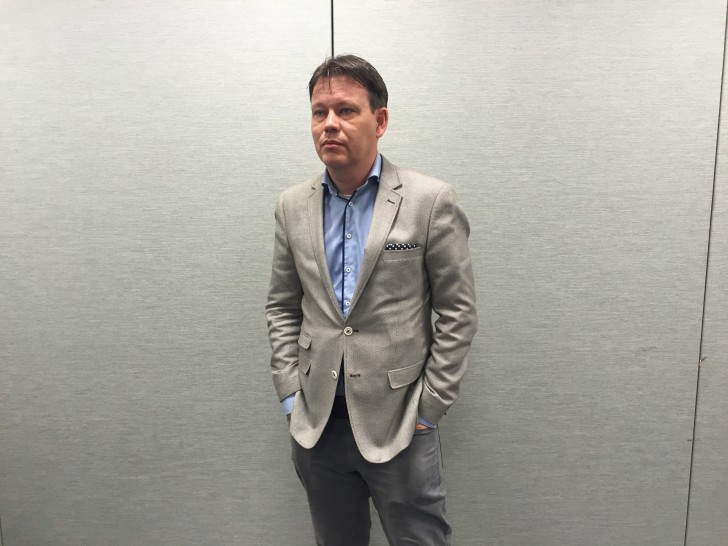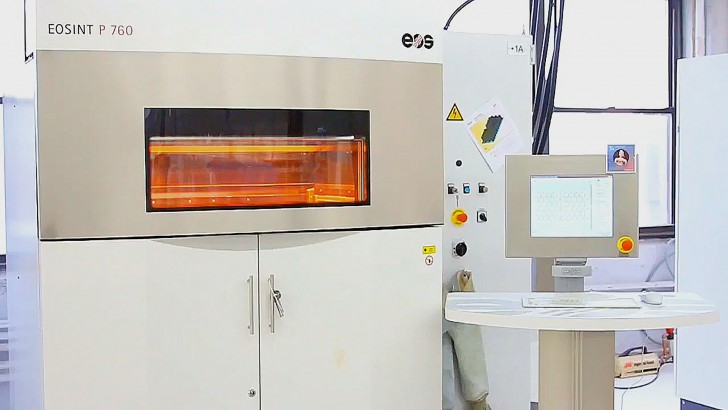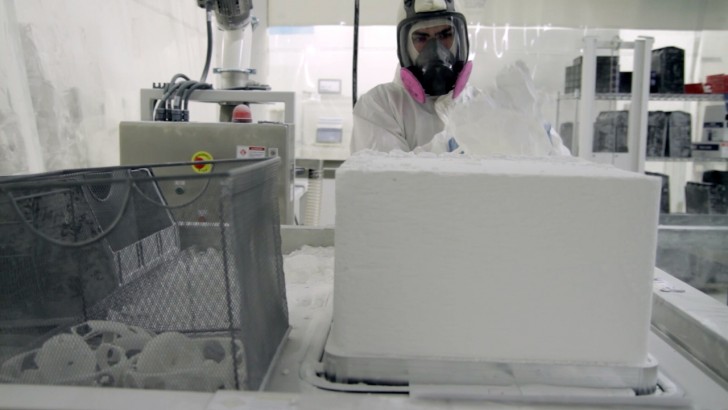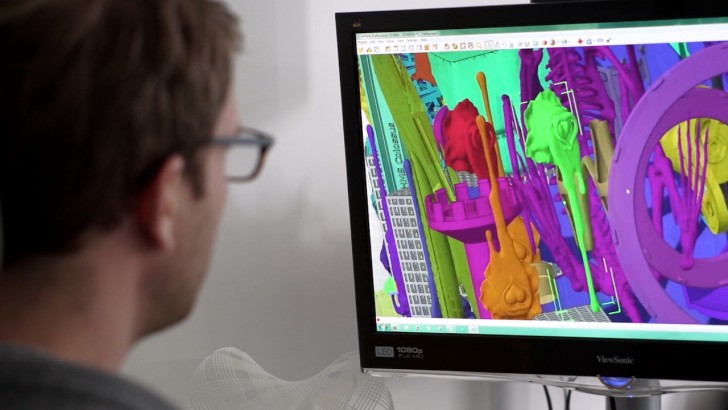Shapeways has been working to connect shoppers and 3D designers together since it was started by long-time technology enthusiast Pete Weijmarshausen in Eindhoven, Netherlands in 2007. Since their founding, Shapeways has become a leader in providing designers and makers with a platform to sell high-quality 3D printed products, expanding out of Europe and into New York City and Seattle over their relatively long history with 3D printing. The Shapeways platform allows their users to market, price, and manufacture their designs in almost any material imaginable, from your everyday thermoplastics to precious metal materials.
I was fortunate enough to sit down with Weijmarshausen at Inside , just before his keynote on “Digital Manufacturing and The Next Industrial Revolution”, where he addressed an eager crowd with optimism about the next generation of 3D printing machines and the evolution of the industry as a whole. After his talk was finished, it seemed that everyone wanted to hear more about what Weijmarshausen thought, a testament to the respect and high-quality services provided by the Shapeways platform. When I sat with Weijmarshausen, I noticed his keen focus on improving the community of Shapeways, while we also discussed the importance of 3D printing materials, the company’s new curation process, and also about why 3D scanning technology will ultimately help the industry become more consumer friendly.

Our interview came on the cusp of a new Shapeways material, Black High Definition Acrylate, which showcases one of the few ways Shapeways has managed to stay ahead of the pack. With their latest material, they’ve been able to produce a higher quality option at a lower price. Weijmarshausen explained, “Over the last couple of years, we’ve seen that our community likes to make really high detailed collectables, for board games, set place pieces, model train accessories. In that category, more detail is always better. And, also, not surprisingly, better prices are what people are also looking for, as well. I’d been looking at the technology the we’re now using from EnvisionTEC for quite a while, and we finally managed to deliver this to our community, enabling them to make even higher quality products, beautiful black models at a better price. We’ve been able to lower the price compared to our last high definition material by about 20%, while at the same time delivering higher quality parts. We launched this material just 10 days ago, and the demand has outstripped expectations by four times the amount.”

When I asked Weijmarshausen what he thought set Shapeways apart from competitors such as Sculpteo and i.materialise, there seemed to be two factors that he focused on: their broad range of materials and wide-reaching community. “We are the leaders in the variety of materials that we offer. It’s not only that we deliver lots and lots of colors and plastics, but we also offer stainless steel, bronze, brass, gold, silver, platinum, very high quality porcelain in a variety of colors. So, it’s definitely the multitude of materials,” Weijmarshausen started.
“After that, we have, by far, the largest community, not only in terms of people making stuff, but also in terms of our marketplace, where over 38,000 people have already opened their stores and are selling their products.” He continues, “That lowers the barrier for people to engage for the first time, because there are so many possibilities and things you can do just by buying something that someone else has designed. It’s an easy way to get started and see what is possible through 3D printing. On top of that, we now have our Custom Maker tool; with that, designers can make their designs customizable. Now, me or you or any user can go and type in text and it will immediately show up on the design, so you can see what you’re doing. You can also upload a picture that can be engrave or embossed as well. So, now I can personalize it, and I think the magic sits not in the fact that I can have this customizable iPhone case, but the magic sits in the fact that our designers are now free to make their designs customizable. The combination of those things make Shapeways a very compelling platform.”
As for certain products their store owners are making, the list continues to expand as Shapeways adds to materials to their arsenal. Weijmarshausen talked about how he saw first-hand how innovative products were driven by material capabilities, “I think it follows materials. When we started, we just offered a few plastics, and people would make miniatures, toys, and gadgets. But when we introduced the first metals way back in 2009, the first thing people started to do was make their own jewelry. So I understood that materials open up new categories of products, and that encourages us to offer silver and other precious metals, but also brass and bronze. Then, we found a way to start offering ceramics. With that came a lot of home decor, think coffee cups, vases, bowls, beautiful things for the home started to appear.”
Now that Shapeways has their factory and website running at its fullest extent to-date, Weijmarshausen and his team are focused on cultivating a wider sense of community on their platform. Though they do have a massive user-base already, Shapeways is looking to continue expanding into new customer territories, “What we’ve been neglecting a little bit is the social element, because people who are doing this want to connect with each other,” Weijmarshausen said. “We had a forum and a blog, but it was still a bit limited, so one of things we released earlier this year is the fact that users can now follow designers, they can comment on the activities that the designer is doing. So, you get a bit of a social timeline centered on products, but based on the community. It does a multitude of things: it makes the discovery of products that you like much easier. If you realize that Shapeways gets about 200,000 new designs every month, finding what you like becomes a bit of a challenge. So, following the right designers helps you filter that down to things you really like.”
The curation service that Shapeways recently implemented is creating a new kind of user aside from sellers and buyers. Now, curators can help bridge the buyer and seller by tastefully curating the massive amount of products on Shapeways into easily navigable collections.“Next to that, if you look at the reasons why people use Shapeways, you can break it down into two activities: people who are designing and making, and people who are buying,” Weijmarshausen explained. “That by itself is interesting, but with this social curation of products, there is now a new category of users emerging, who I would call curators. You don’t have to be a designer; you don’t need to be a buyer; you can go the Shapeways and find beautiful and aesthetic products that appeal to you. Now you can curate that. If I follow several curators, finding products that are very appealing to me becomes way more easy.”
When I asked Weijmarshausen about what he foresaw for the future of 3D printing technology, he turned to 3D scanning as the way to get the technology out of its niche and into the mainstream, “I think it starts with figuring out what the key use case is that makes the mainstream audience wanting to use 3D printing technology. People who love new technologies, are not afraid of it, will go through the hardships even if it doesn’t work as intended but will use it nonetheless. I’m like that. But, then, of course, there is a much larger group of people who want it to be easy and understand why it’s for them in five seconds, or else they will disengage. I think one of those things is going to be 3D scanning of people. Everyone has known about scanning for years, but I was never particularly excited about 3D scanning objects. Yeah it’s interesting, but loads of things can not be scanned well. Until, at some point, we ran a small experiment of scanning people at SXSW at parties, people went nuts. We gave them codes so they could find their scan on our site and buy it, and I had no hopes that people would even remember being scanned the next day, to my surprise, more than 10% of the people did,” Weijmarshausen concludes.



Leave A Comment